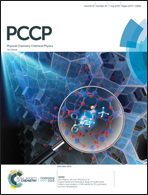Amphiphilic copolymers change the nature of the ordered-to-disordered phase transition of lipid membranes from discontinuous to continuous†
Abstract
The phase behaviour as a function of temperature is explored for pure phospholipid (DPPC) and hybrid lipid–polymer (DPPC/Pluronic L64) bilayers with the aid of atomistic MD simulations. The range of the fixed-temperature simulations includes temperatures below and above the known melting temperature (Tm) for DPPC membranes. For the pure lipid bilayer, the main phase transition is discontinuous, as verified by the abrupt changes observed in the membrane structure, elasticity and the lipid diffusivity near the critical temperature Tm, which lies in the region 298.15–303.15 K. A pre-transition step is detected at 298.15 K which has been identified as the ripple phase (Pβ′), where ordered and disordered lipids coexist, causing thickness fluctuations. In the ordered gel phase, the positional ordering as assessed by the lipid radial distribution functions is long-range and some degree of hexagonal packing is measured. The hybrid bilayers on the other hand, transform from a more ordered to a disordered phase in a continuous manner, without finite jumps in their properties. No signs of the ripple phase are identified and the ordered phase exhibits very limited hexagonal packing and some positional ordering that decays fast. The effect of the inserted polymers in the two phases is reversed; at low temperatures, they render the membrane thinner, less cohesive and less ordered compared to the pure one, with the lipids assuming faster diffusion rates, whereas at high temperatures, the polymer interaction with the lipids acts reducing their diffusivity, but also increasing the lipid tail ordering and the membrane stiffness. The ability of the amphiphilic L64 copolymers to change the nature of the main phase transition of lipid membranes and their properties both in the ordered and the disordered phase is of vital importance for the prediction of both the efficacy of hybrid lipid/polymer nanoparticles as drug delivery vehicles as well as their potential adverse implications during interactions with healthy cell membranes.



 Please wait while we load your content...
Please wait while we load your content...